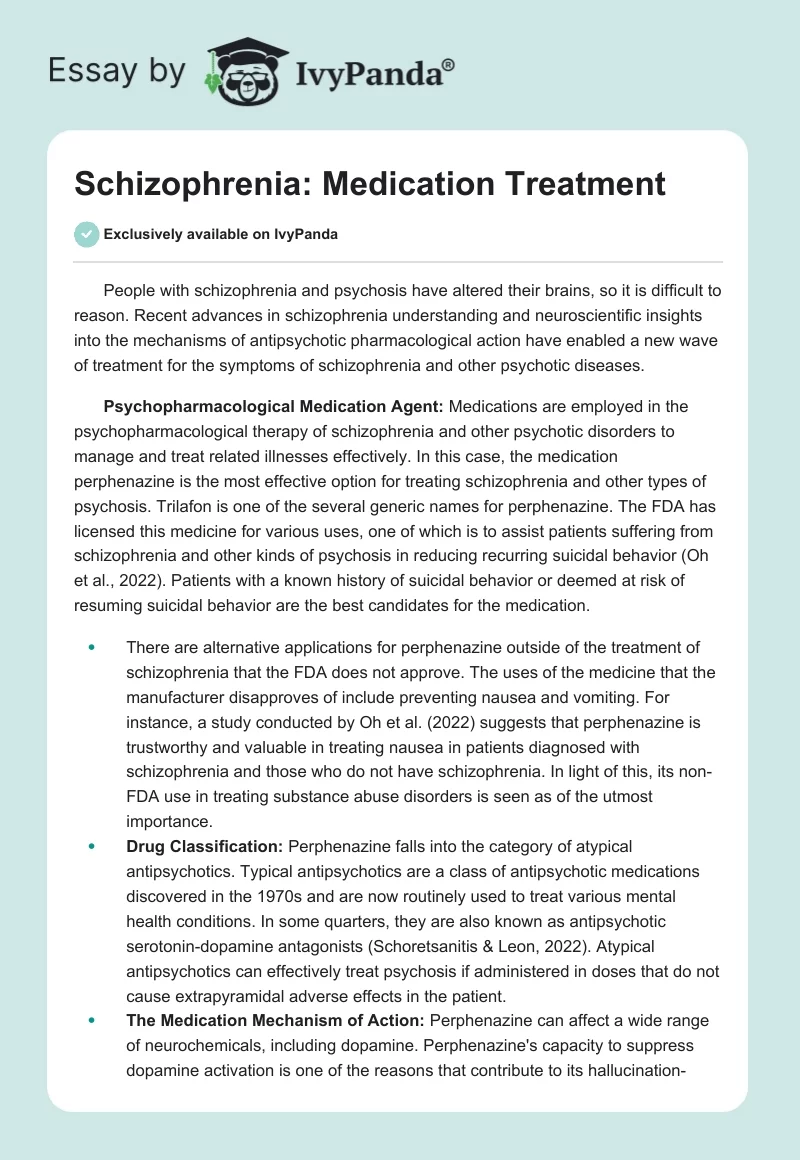People with schizophrenia and psychosis have altered their brains, so it is difficult to reason. Recent advances in schizophrenia understanding and neuroscientific insights into the mechanisms of antipsychotic pharmacological action have enabled a new wave of treatment for the symptoms of schizophrenia and other psychotic diseases.
Psychopharmacological Medication Agent: Medications are employed in the psychopharmacological therapy of schizophrenia and other psychotic disorders to manage and treat related illnesses effectively. In this case, the medication perphenazine is the most effective option for treating schizophrenia and other types of psychosis. Trilafon is one of the several generic names for perphenazine. The FDA has licensed this medicine for various uses, one of which is to assist patients suffering from schizophrenia and other kinds of psychosis in reducing recurring suicidal behavior (Oh et al., 2022). Patients with a known history of suicidal behavior or deemed at risk of resuming suicidal behavior are the best candidates for the medication.
- There are alternative applications for perphenazine outside of the treatment of schizophrenia that the FDA does not approve. The uses of the medicine that the manufacturer disapproves of include preventing nausea and vomiting. For instance, a study conducted by Oh et al. (2022) suggests that perphenazine is trustworthy and valuable in treating nausea in patients diagnosed with schizophrenia and those who do not have schizophrenia. In light of this, its non-FDA use in treating substance abuse disorders is seen as of the utmost importance.
- Drug Classification: Perphenazine falls into the category of atypical antipsychotics. Typical antipsychotics are a class of antipsychotic medications discovered in the 1970s and are now routinely used to treat various mental health conditions. In some quarters, they are also known as antipsychotic serotonin-dopamine antagonists (Schoretsanitis & Leon, 2022). Atypical antipsychotics can effectively treat psychosis if administered in doses that do not cause extrapyramidal adverse effects in the patient.

- The Medication Mechanism of Action: Perphenazine can affect a wide range of neurochemicals, including dopamine. Perphenazine’s capacity to suppress dopamine activation is one of the reasons that contribute to its hallucination-reducing effects. It not only improves attention and focus but also regulates the amount of the neurotransmitter dopamine in other brain sections. Additional effects on brain chemicals give it a higher therapeutic index and reduce the possibility of side effects connected to movement or hormones.
- The medication pharmacokinetics: Perphenazine is absorbed into the body first through the mouth after taking it by mouth. Its bioavailability is affected by the first-pass metabolism, which limits it to between 60 and 70 percent (Siskind et al., 2021). Although the food does not influence the medication’s bioavailability, consuming it simultaneously with the medication can drastically impair the target absorption rates. An extensive medicine causes the liver to metabolize the medicine, which results in the medicine being removed from the body through feces and urine.
- The medication pharmacodynamics: Perphenazine can potentially reduce the symptoms of depression, anxiety, and decreased cognitive performance associated with schizophrenia by acting as a 5-HT2A antagonist at the serotonin receptor. Perphenazine’s activity is explained by the fact that it promotes the release of glutamate and D-serine from the NMDA receptor’s glycine region (Siskind et al., 2021). As a result, the degree of expression of glutamate transporters in astrocytes decreases.
Mechanism of Action: A modification in the activity of dopamine is connected with the mechanism of action of perphenazine. There is a correlation between higher dopamine activity in some regions of the brain and increased schizophrenia symptoms. On the other hand, an increase in negative cognitive symptoms is associated with a reduction in the activity of the neurotransmitter dopamine.
Appropriate dosing, administration, route, and considerations for dosing alterations: When used by mouth, the medicine perphenazine can come in several different forms. The three most prevalent are pills, dissolving tablets, and oral suspension. If the doctor instructs, one can take it more frequently. The recommended dosage is once or twice a day; however, it can be used more frequently if necessary. Patients should begin treatment with a dosage ranging from four to eight milligrams taken daily.
Definition of half-life, the importance of half-life, and the half-life of the medication: The half-life of medicine is the amount of time it takes for the active ingredient in the body to decrease by half. The half-life of a drug is determined by how the body processes it. There are a variety of possible times, ranging from hours to weeks. It is critical to grasp the half-life concept for determining how rapidly drugs exit the body.
Side effects: Drowsiness, poor vision, convulsions, and an inability to think clearly or manage one’s activities are all possible side effects. Perphenazine may induce stomach and intestinal difficulties. Diabetes patients should be advised that this medication has the potential to raise their blood sugar levels. Perphenazine can also temporarily decrease the number of white blood cells in the blood, which raises the risk of infection.
Contraindications for use, including significant drug-to-drug interactions: Some patients hypersensitive to the formulation have a higher risk of experiencing significant hypersensitivity reactions. Myocarditis, neutropenia, orthostatic hypotension, and dementia are other conditions that should not be treated with this medication. The most potentially harmful interaction with perphenazine is with the drug fluvoxamine, which inhibits the bulk of the enzymes involved in perphenazine clearance. Providing carbamazepine, phenytoin, or rifampicin alongside perphenazine is not recommended since these medications increase the dose of perphenazine.
Considerations: When prescribing for a patient, a physician must consider various factors to ensure their well-being. The considerations include overdose, diagnostic and lab monitoring, comorbidities, essential patient factors, and legal and ethical considerations.
- Overdose considerations: While filling prescriptions, a medical professional could make a mistake that results in an overdose. In order to ensure that necessary steps are taken to decrease the adverse effects linked with the symptoms of an overdose, it is crucial to focus on the side effects of an overdose. On the other hand, supportive care can be used to treat the toxicity levels caused by perphenazine.
- Diagnostics and labs monitoring: The existence of heart disease or abnormal results from a cardiac examination is a diagnostic factor to be taken into consideration. Since perphenazine causes an increase in the rate at which the heart beats, this consideration is very significant. The diagnostic considerations contribute to the prevention of cardiac issues that are connected with the use of perphenazine.
- Comorbidities considerations: Detecting the presence of two or more diseases in a patient is one of the tasks involved in comorbidity considerations. When utilizing a particular medication, the effects could result in undesirable side effects. People who take perphenazine are at an elevated risk of cardiovascular events as well as death because of the existence of other medical conditions.
- Pertinent patient considerations: Patient consideration requires efficient communication throughout medicine delivery to ensure satisfaction and assurance during therapy. For instance, a harmful event such as an overdose might occur during the process of considering and administering the drug.
- Legal and ethical considerations: When making decisions, the gender of the patient, their age, and their current condition of health is taken into consideration (Ventura et al., 2022). For instance, despite other factors, such as that women are more likely to smoke, it takes around 20% less perphenazine for females to obtain the same plasma levels as males.
References
Oh, H. S., Lee, B. J., Lee, Y. S., Jang, O.-J., Nakagami, Y., Inada, T., Kato, T. A., Kanba, S., Chong, M.-Y., Lin, S.-K., Si, T., Xiang, Y.-T., Avasthi, A., Grover, S., Kallivayalil, R. A., Pariwatcharakul, P., Chee, K. Y., Tanra, A. J., Rabbani, G., … Park, S.-C. (2022). Machine learning algorithm-based prediction model for the augmented use of clozapine with electroconvulsive therapy in patients with schizophrenia. Journal of Personalized Medicine, 12(6), 969. Web.
Schoretsanitis, G., & Leon, J. de. (2022). Best practices for starting clozapine in patients with schizophrenia. The Journal of Clinical Psychiatry, 83(4). Web.
Siskind, D., Orr, S., Sinha, S., Yu, O., Brijball, B., Warren, N., MacCabe, J. H., Smart, S. E., & Kisely, S. (2021). Rates of treatment-resistant schizophrenia from first-episode cohorts: Systematic Review and meta-analysis. The British Journal of Psychiatry, 220(3), 115–120. Web.
Ventura, A. M., Hayes, R. D., & Fonseca de Freitas, D. (2022). Ethnic disparities in clozapine prescription for service-users with schizophrenia-spectrum disorders: A systematic review. Psychological Medicine, 52(12), 2212–2223. Web.


